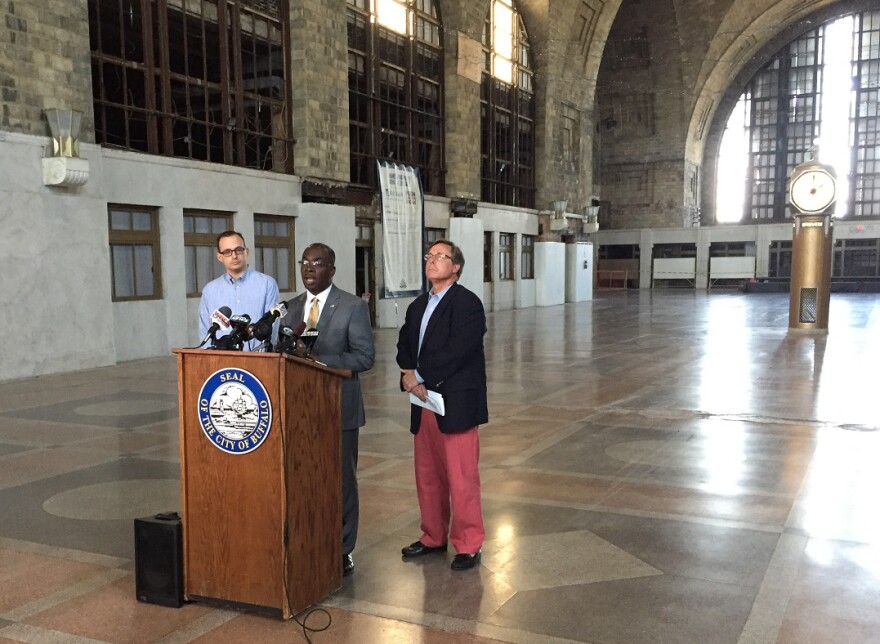A team of experts will be in Buffalo next week to study the Central Terminal and offer recommendations for how to reuse the East Side landmark. The study comes weeks after a locally-assembled panel, organized to choose a site for Buffalo's new train station, chose not to reopen the Terminal for that purpose.
The Urban Land Institute, which previously studied Buffalo properties including the H.H. Richardson complex and former Millard Gates Circle hospital complex will begin its work on June 25.
The Central Terminal Restoration Corporation, shortly after announcing it was ending its development rights agreement with Canadian developer Harry Stinton, revealed last month it would work with ULI to determine a future course of action. The institute previously studied other Buffalo properties including the H.H. Richardson complex and former Millard Gates Circle hospital complex.
"It's a tremendous opportunity," said Paul Lang, vice chairman of the CTRC. "We really appreciate the chance to be in the same sentence, the same category as some of the prestigious projects in the area. We're looking forward to seeing some of the same results in the future."
The City of Buffalo and Empire State Development are providing $50,000 each to fund the project. The ULI Foundation is providing $35,000 as well. Mayor Byron Brown, standing in the Central Terminal on Tuesday, said a dozen experts from across the nation will gather in Buffalo on Sunday, begin their work the following day and then present their findings and recommendation on the following Friday.
"The team received a 70-plus-page binder of background information on the Central Terminal to study before their arrival," Mayor Brown said. "They will be well-prepared for a day on site at the complex to start their intense analysis."
The mayor said ULI participants will interview an estimated 100 stakeholders from various sectors. The scope of the study will include determining what mix of uses would be most appropriate for market and neighborhood revitalization, determining a logical sequence of next steps for Central Terminal development, figuring out options for financing, deciding whether transportation may still play a role on the complex and determining what types of residential uses might be reasonable as an included component.
ULI will also be charged with determining how best to ensure the historic integrity of the grounds. Sam Hoyt, regional president of Empire State Development, said Buffalo has had a sketchy history in terms of preserving its architectural gems but has improved on it since.
"By bringing in the Urban Land Institute, we're bringing in a panel of national and international experts who are going to give us their guidance, who are going to give us their expertise and time, to help us create a framework for possible reuse and restoration of this building," Hoyt said.
Stinson recently put forth his own plan for reusing the Terminal. Officials say he'll participate in the interview process and will be welcomed to submit a proposal, along with other interested parties.
Congressman Brian Higgins, who campaigned for reopening the Central Terminal as the city's future train station, welcomed ULI's involvement in a written statement: “Buffalo’s Central Terminal is a central piece of the City’s skyline but its grand presence as an iconic historic landmark is only outdone by the presence it holds in the hearts and minds of the people in this community.
“Last October we initiated a determined effort to refocus on the Central Terminal and the greater Broadway-Fillmore neighborhood. What stood out most throughout the last several months is the genuine affection for the Central Terminal felt by residents across Western New York and beyond.
“The Urban Land Institute is an experienced and respected nonprofit organization that has a track record of involvement in transformative projects, including rehabilitation of the Richardson Olmsted Complex, which underwent a $102.5 million rehabilitation that included more than $76 million in New York State funding and an additional $16 million in historic tax credits.
“We welcome this process and I look forward to advocating for the future of the Central Terminal in the Urban Land Institute panel interviews next week. The time is now to refocus on the Central Terminal.”







